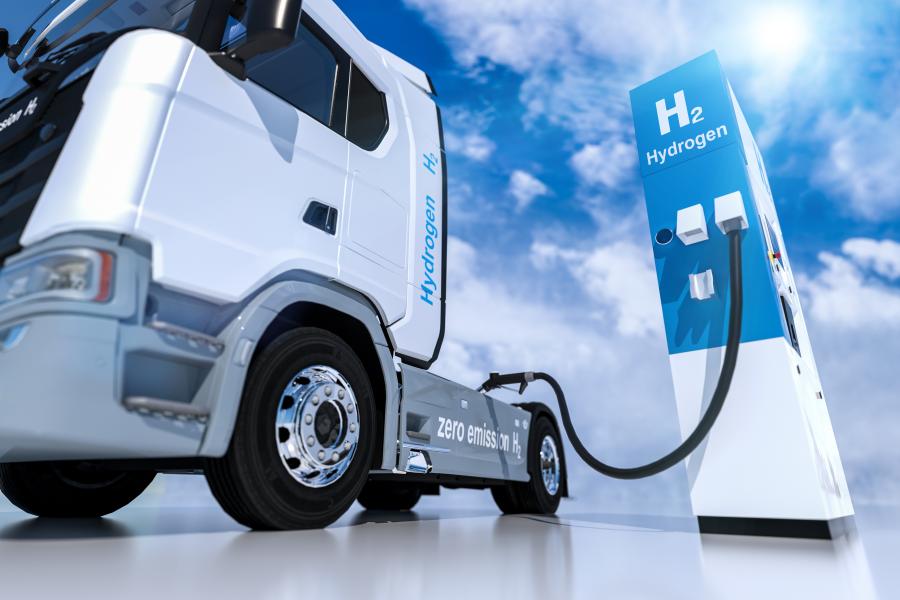Despite the fact that alternative-fuel construction machines have been around a while, potential buyers may not be well-enough informed about the availability and specifications of electric construction equipment.
Long before President Joe Biden made a nationwide goal of 100 percent clean energy and net-zero emissions by the year 2050, construction equipment manufacturers were doing their part. So were project owners, specifying eco-friendly machines on job sites. Contractors stocked electric and hybrid machines and hired operators to run them.
But Biden's edict aside, the industry is driving closer toward mainstreaming of zero-emission construction equipment.
In fact, The Bellona Foundation, a global non-profit fighting climate challenges, has found that there is currently an electric alternative for at least seven different types of construction machines.
Bellona started tracking the manufacture of zero-emission construction equipment, establishing a database that "combines all the available electric construction machinery and equipment that can help eliminate emissions and reduce noise from the job site."
Getting the Word Out
The organization has found that at least 18 manufacturers offer equipment and components to support the electric revolution. These companies are cranking out eco-friendly excavators, wheel loaders, dumpers, vibratory plates, slew and track drives and cement mixers. And that's just what Bellona has logged. Other manufacturers are joining the cause.
"Even though there is already a good selection of products available on the market today, it seems like potential buyers are not informed well enough about the availability and the specifications of electric construction equipment," the organization said.
Bellona added that due to these advances in the market sector, contractors now have the opportunity to make an active choice for construction equipment that neither harms the surrounding environment nor the local community while still doing the job. "For the market there is only room to grow," the organization said.
The Association of Equipment Manufacturers (AEM) wants its members to stay informed as they grow with the market. The newly-formed Engine Emissions Strategy Task Force (EESTF) has a goal of helping guide AEM's efforts to keep members and the off-road industry up to date on equipment emissions regulations.
EESTF will work to educate professionals on potential future emissions requirements, changes to power trains, the impact on equipment design and cost implications, according to AEM. Another potential goal is to help others understand that a different technology solution for different applications and machine types may exist.
Alternative Technology Solutions
Different eco-friendly technology solutions have existed and continue to launch each year. Electric and hybrid small machines have been used in indoor construction and maintenance for years now. But, as Volvo put it, "quietly in the background, electric vehicles have been heading off the road and onto construction job sites."
Heavy equipment manufacturers were out in front, putting lower-emission engines in their machines over the years, adding features that reduce fuel consumption and developing telematics systems to help operators reduce fuel usage and idling time.
But heavy equipment like excavators and wheel loaders are just now becoming available in electric options, ushering in a new era of electromobility.
"Electric machines are going to build the roads, bridges and utility lines of tomorrow, and they're going to do it without producing greenhouse gas emissions," said Ray Gallant, head of product management and productivity of Volvo CE. "There are already early adopters successfully using electric construction equipment, and they're finding that they can lower their carbon footprint while keeping their performance high."
He believes the industry has come a long way in reducing emissions, and there is still room for improvement but "we're at a point where most of the benefits have been realized. New technologies like electric machines are the next frontier in emissions reductions."
The challenges in bringing electromobility to the construction industry include building out the charging infrastructure. Manufacturers are finding work-arounds.
Volvo's electric excavator and wheel loader, coming to the United States this year, can be charged in a 220/240-volt electrical socket. They also are available with fast-charge options, getting them close to peak charge in a couple of hours. The company believes that with fast-moving development the industry will soon see options such as mobile power banks for charging in remote locations.
"Our customers will not notice a difference between the power and performance of the electric machines versus the diesel models," said Lars Arnold, Volvo CE electromobility product manager. "In fact, they'll enjoy several benefits with the electric machines thanks to the lack of a diesel engine, including lower noise, less machine vibration and no exhaust fumes."
Power and performance are being generated through natural gas and hydrogen cell technology, both of which are gaining ground in the zero-emission front.
Representatives from the California Natural Gas Vehicle Partnership (CNGVP) recently reported that fleets are increasingly turning to near-zero emission natural gas vehicles and carbon-negative renewable natural gas.
Today, fleets across California and the nation are investing in commercially available and proven natural gas vehicles, said Ashley Remillard, vice chair of CNGVP.
Fleet owners are "choosing sustainable technology that meets their wide ranging and intensive operational needs while keeping an eye on future opportunities to incorporate electric trucks," she added.
At the same time, research and development of hydrogen and fuel cells for construction applications is growing. Hydrogen is considered a good fuel source for the on-highway sector, but several manufacturers are combining forces to bring the technology to earth work, mining and other off-high applications.
Hydrogen fuel cells are no-combustion technology that requires a constant source of fuel and oxygen to create electricity and emits only water.
Hydrogen tanks on a fuel cell electric car or truck can be refilled in about the same amount of time as liquid fuel tanks, eliminating the lengthy recharging times required by battery-dependent electric vehicles.
Hydrogen is available today from a variety of carbon-free and low carbon sources, providing low or even negative total carbon emissions from transport fleets, and zero smog-forming pollutants.
How Feasible Is It?
The vehicle group of power technology manufacturer Eaton announced a partnership with Ballard Fuel Cell Systems and the National Renewable Energy Lab to develop heavy-duty truck fuel cell technology using hydrogen fuel cells.
The Green Car Congress reports that Eaton received a grant from the US. Department of Energy to develop highly efficient fuel cells capable of powering heavy-duty machinery.
Eaton's Twin Vortices Series (TVS) technology is at the heart of the partnership, according to Karl Sievertsen, vice president and CTO of Eaton's Vehicle Group.
"Our TVS supercharger technology provides fuel cell manufacturers with a precise amount of controlled air to increase power and efficiency," he said. "The efficiency of competitive fuel cells is lower because most hydrogen fuel cells use simple fans for air flow, which produces less pressure and is not controllable."
ABB, Zurich, Switzerland, has signed an agreement with MEDATech of Ontario, Canada, to explore net-zero emission technology in the mining industry.
The goal is to explore solutions to decarbonize mining operations through charging solutions and optimized electric drive systems in battery electric vehicles for heavy-duty applications.
Electric vehicles and matching charging infrastructure must meet demanding requirements for mining customers, including high power, automated and safe operations and ruggedized design for harsh environmental conditions.
"The mining sector has set clear and ambitious targets to decarbonize operations for a more sustainable future," said Nic Beutler, ABB's global product manager power system & charging solutions.
An agreement between Caterpillar and Nouveau Monde to develop zero-emissions mining equipment was announced this summer. Nouveau Monde hopes to become the exclusive supplier of all electric mining equipment at Matawinie Mine in Quebec, Canada, by 2028.
Cat will work with the company to incorporate the customer's voice throughout the development, and for testing of the zero-emission fleet and infrastructure prior to commercial production.
Meanwhile, back at ACT Expo, a sustainably focused hybrid truck powertrain offering reduced weight and simplified installation, service and operation was on display this year.
Newcomer Hyliion, based in Cedar Park, Texas, produces electrified powertrain systems to augment or replace traditional diesel- or natural gas-fueled powertrains.
This enhanced version of the company's Hybrid powertrain is aimed at Class 8 diesel and CNG commercial trucks. Deliveries are planned for late this year. Thomas Healy, Hyliion founder, said the company expects the improvements "to make the system easier for fleets to adopt while also helping them achieve their emissions targets."
Also at the expo in Long Beach, Calif., was a Class 6 and 7 fuel-cell electric truck powered by Hexagon Purus of Norway and Ballard Power Systems of Canada. Hexagon Purus' turnkey electric drivetrain and hydrogen storage system was combined with Ballard's fuel cell module.
The partners said the truck will provide a range of more than 400 mi. and refueling times comparable to conventional trucks. They're marketing it as a zero-emission solution for fleet owners with demanding operations, moving goods through the ‘middle miles,' without the need to expand their fleet.
This truck should land on California's hybrid and zero-emission voucher incentive program list in 2022. First fleet deployments are planned for the Los Angeles Basin area.
"Fuel cell and hydrogen technologies will enable the decarbonization of the heavy-duty transportation sector with long range and quick vehicle refueling, without compromising on payload," said Nicolas Pocard, vice-president marketing of Ballard Power. CEG
Lucy Perry
Lucy Perry has 30 years of experience covering the U.S. construction industry. She has served as Editor of paving and lifting magazines, and has created content for many national and international construction trade publications. A native of Baton Rouge, Louisiana, she has a Journalism degree from Louisiana State University, and is an avid fan of all LSU sports. She resides in Kansas City, Missouri, with her husband, who has turned her into a major fan of the NFL Kansas City Chiefs. When she's not chasing after Lucy, their dachshund, Lucy likes to create mixed-media art.
Read more from Lucy Perry here.
Today's top stories














